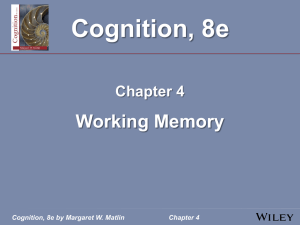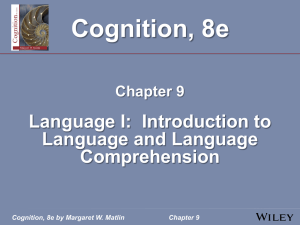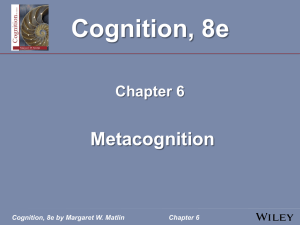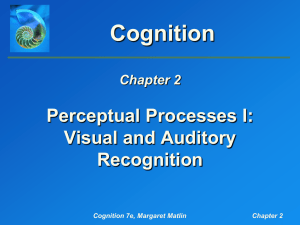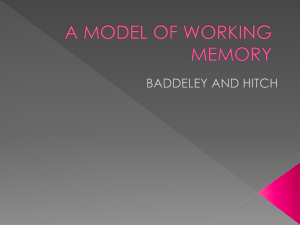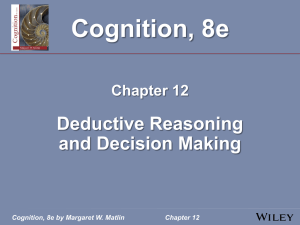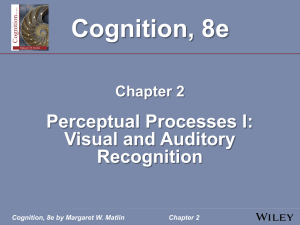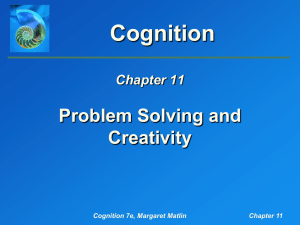Matlin, Cognition, 7e, Chapter 4: Working Memory
advertisement
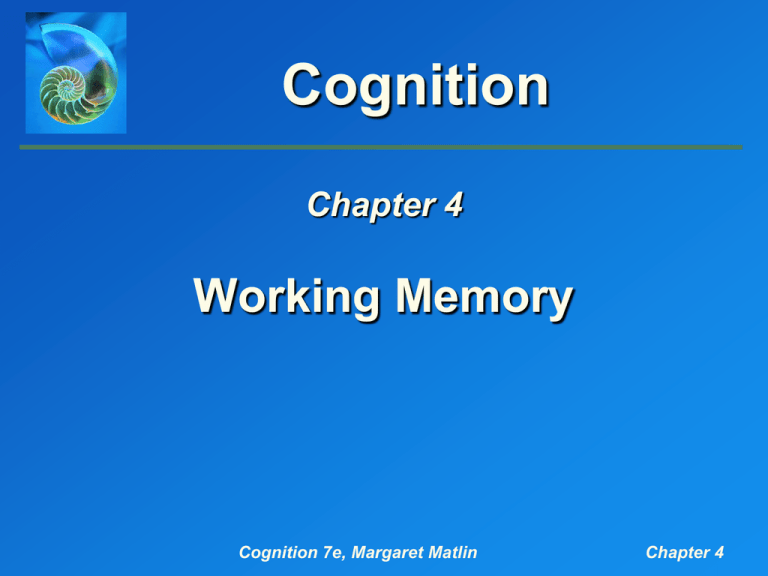
Cognition Chapter 4 Working Memory Cognition 7e, Margaret Matlin Chapter 4 Introduction working memory short-term memory long-term memory Cognition 7e, Margaret Matlin Chapter 4 The Classic Research on Working Memory George Miller's "Magical Number Seven" suggested that people can remember about seven items (give or take two) chunk as memory unit proposed that people engage in internal mental processes in order to convert stimuli into a manageable number of chunks Cognition 7e, Margaret Matlin Chapter 4 The Classic Research on Working Memory Other Early Research on Short-TermMemory Capacity The Brown/Peterson & Peterson Technique material held in memory for less than a minute is frequently forgotten remember three items; count backwards by threes rehearsal Cognition 7e, Margaret Matlin Chapter 4 Brown/Peterson & Peterson—Typical Results Cognition 7e, Margaret Matlin Chapter 4 The Classic Research on Working Memory Other Early Research on Short-TermMemory Capacity The Recency Effect serial position effect recency effect primacy effect used to measure the size of short-term memory Cognition 7e, Margaret Matlin Chapter 4 Serial Position Effect Cognition 7e, Margaret Matlin Chapter 4 The Classic Research on Working Memory Atkinson and Shiffrin's Model control processes Other Factors Affecting Working Memory's Capacity Pronunciation Time short names vs. long names numbers in different languages acoustic properties of stimuli Cognition 7e, Margaret Matlin Chapter 4 Pronunciation Rate & Memory Span Cognition 7e, Margaret Matlin Chapter 4 The Classic Research on Working Memory Other Factors Affecting Working Memory's Capacity (continued) Semantic Similarity of the Items in Working Memory semantics Wickens and colleagues (1976) proactive interference (PI) release from proactive interference Brown/Peterson & Peterson task varying semantic similarity on Trial 4 Cognition 7e, Margaret Matlin Chapter 4 Release from Proactive Interference Cognition 7e, Margaret Matlin Chapter 4 The Working-Memory Approach Alan Baddeley & Graham Hitch (1974); Baddeley (2000, 2001, 2006) What does short-term memory accomplish for our cognitive processes? Cognition 7e, Margaret Matlin Chapter 4 Baddeley’s Model of Working Memory Cognition 7e, Margaret Matlin Chapter 4 The Working-Memory Approach working-memory approach—our immediate memory is a multipart system that temporarily holds and manipulates information as we perform cognitive tasks • • • • central executive visuospatial sketchpad episodic buffer phonological loop emphasis on active manipulation of information in working memory Cognition 7e, Margaret Matlin Chapter 4 The Working-Memory Approach Evidence for Components with Independent Capacities Working memory is not unitary Baddeley & Hitch (1974) random numbers and spatial reasoning task Cognition 7e, Margaret Matlin Chapter 4 The Working-Memory Approach In Depth: Phonological Loop phonological loop—processes a limited number of sounds for a short period of time subvocalization Cognition 7e, Margaret Matlin Chapter 4 The Working-Memory Approach In Depth: Phonological Loop Research on Acoustic Confusions acoustic confusions Similar sounding items are more difficult to recall BDPTVC KMFQZL Conrad & Hull (1964) list of letters, presented visually lists of words Cognition 7e, Margaret Matlin Chapter 4 The Working-Memory Approach In Depth: Phonological Loop Other Uses for the Phonological Loop counting reading acquiring new vocabulary learning foreign language mathematical calculations problem-solving tasks complex task instructions Cognition 7e, Margaret Matlin Chapter 4 The Working-Memory Approach Neuroscience Research on the Phonological Loop Cognition 7e, Margaret Matlin Chapter 4 The Working-Memory Approach Visuospatial Sketchpad visuospatial sketchpad—processes both visual and spatial information store appearance and relative position store visual information encoded from verbal stimuli limited capacity Cognition 7e, Margaret Matlin Chapter 4 The Working-Memory Approach Visuospatial Sketchpad Research on the Visuospatial Sketchpad performing two visuospatial tasks simultaneously no standardized set of visual stimuli tendency to provide names for visual stimuli, thus using phonological loop instead Brandimonte and colleagues (1992)—say "la la la" while looking at complex visual stimulus Cognition 7e, Margaret Matlin Chapter 4 The Working-Memory Approach Visuospatial Sketchpad Other Uses for the Visuospatial Sketchpad engineering art architecture retaining image of a scene finding your way from one location to another videogames, jigsaw puzzles, mazes television Cognition 7e, Margaret Matlin Chapter 4 The Working-Memory Approach Neuroscience Research on the Visuospatial Sketchpad Parietal and frontal areas are active during mental rotation Cognition 7e, Margaret Matlin Chapter 4 The Working-Memory Approach Central Executive central executive—integrates information from the phonological loop, the visuospatial sketchpad, the episodic buffer and from long-term memory Characteristics of the Central Executive plans and coordinates, but does not store information executive supervisor decides which issues deserve attention selects a strategy limited capacity to perform simultaneous tasks Cognition 7e, Margaret Matlin Chapter 4 The Working-Memory Approach Central Executive The Central Executive and Daydreaming Teasdale and colleagues (1995) random-number generation task report thoughts Neuroscience Research on the Central Executive frontal lobe Cognition 7e, Margaret Matlin Chapter 4 The Working-Memory Approach Episodic Buffer episodic buffer—temporary storehouse where we can gather and combine information from the phonological loop, the visuospatial sketchpad, and long-term memory integrates information from different modalities limited temporary Cognition 7e, Margaret Matlin Chapter 4 The Working-Memory Approach Individual Differences: Major Depression and Working Memory Working memory performance is related to: • overall intelligence and grades in school • verbal fluency, reading comprehension, reasoning ability, note-taking skills • reading ability • Attention-deficit/hyperactivity disorder Cognition 7e, Margaret Matlin Chapter 4 The Working-Memory Approach Individual Differences: Major Depression and Working Memory Major depression Christopher and MacDonald (2005) phonological loop visuospatial sketchpad central executive difficulty concentrating unwanted negative thoughts Cognition 7e, Margaret Matlin Chapter 4 Alterations in the Functional Anatomy of Working Memory in Adult Attention Deficit Hyperactivity Disorder Data suggest the use of compensatory mental and neural strategies by subjects with ADHD in response to a disrupted ability to inhibit attention to nonrelevant stimuli and the use of internalized speech to guide behavior. http://ajp.psychiatryonline.org/article.aspx?Volume=157&page=278 &journalID=13 Cognition 7e, Margaret Matlin Chapter 4
